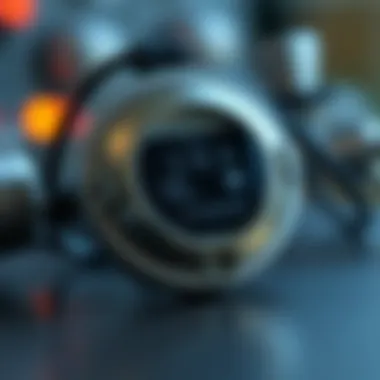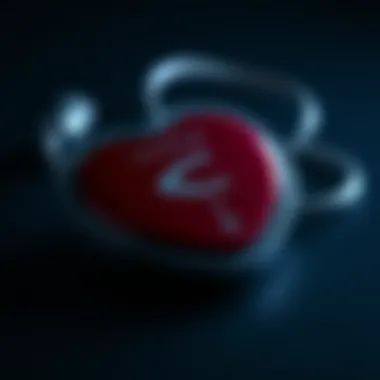Examining Pacemaker Costs and Influencing Factors


Intro
Having a pacemaker can be a daunting prospect for many patients. Understanding the financial implications can be just as complicated as the medical ones. This article aims to break down these complexities and provide an in-depth exploration of why pacemaker prices vary so widely. While the up-front cost may be glaring, factors like geography, type of device, and insurance coverage can create a maze of variables that patients must navigate. As technological advancements continue to enhance pacemaker functionalities, it's vital for patients to grasp the financial landscape that accompanies these innovations.
In this narrative, we’ll dissect the myriad factors that contribute to pacemaker pricing, including the geographical influences that shape costs and the implications that insurance policies impose. A deep dive into the specifics will empower individuals to make informed decisions and lessen the potential surprise of out-of-pocket expenses.
Prelims to Pacemakers
Understanding pacemakers is crucial, not just for the medical community but for patients who are facing decisions about heart health. As these devices can significantly impact quality of life, a thorough grasp of their function, types, and the factors shaping their costs is paramount. This article aims to delve into these aspects to offer insights that could assist readers in navigating the maze of information surrounding pacemaker pricing and its implications.
A pacemaker is more than just a gadget helping hearts rhythmically beat; it’s a lifeline for many individuals. With advancements in technology, pacemakers now come equipped with a variety of functionalities, making them tailored to specific conditions or needs. But as each type varies in capability, so does its price.
Definition and Function of Pacemakers
At its core, a pacemaker is a small medical device that generates electrical impulses to stimulate the heart to beat at a normal rate. It’s typically implanted under the skin in the chest and attached to the heart via one or more wires. The essential purpose of a pacemaker is to manage heart rhythms that are too slow or erratic, ensuring that the body's demand for oxygen is met by maintaining an adequate heart rate. This is particularly crucial for individuals with heart conditions, as their heart might not effectively maintain its rhythm on its own.
Types of Pacemakers
Understanding the different types of pacemakers is vital, as they cater to varying needs and medical situations. Below are the primary types:
Permanent Pacemakers
A permanent pacemaker is designed for long-term use, often implanted surgically to manage chronic heart rhythm issues. Its key characteristic is its ability to function continuously, adjusting heart rate as needed. Many patients find this option reliable due to its durability and functionality. The benefit of permanent pacemakers lies in their consistent support for those who experience ongoing arrhythmias, offering a much-needed peace of mind. However, it's worth noting that implanting a permanent pacemaker requires a surgical procedure, which comes with its risks.
The unique feature of permanent pacemakers is often their ability to adapt to physical activity. They adjust the heart rate accordingly, which is a huge plus for active individuals. In the long run, the disadvantage may include the necessity of regular check-ups to ensure the device’s functionality and wellbeing of the patient.
Temporary Pacemakers
Temporary pacemakers find their place in situations where immediate stabilization of heart function is critical. They can be used in emergencies, such as after a heart attack or during recovery from heart surgery. The key characteristic here is their portability and ease of use, allowing healthcare professionals to quickly manage transient issues.
Their advantage is quite apparent; they can be lifesaving while awaiting a more permanent solution. However, these pacemakers are often considered a stopgap, necessitating close monitoring and possibly leading to complications if left in place for too long.
Implantable Cardioverter Defibrillators (ICDs)
ICDs serve a distinct purpose compared to their pacemaker cousins; they are lifesaving devices that monitor heart rhythms and can deliver shocks if they detect dangerous heart rhythms. The key characteristic of ICDs is their dual functionality, acting both as a pacemaker and a defibrillator.
Patients with a high risk of sudden cardiac arrest often benefit from ICDs due to their proactive approach to managing severe heart issues. However, with greater complexity and advanced technology, the costs associated with ICDs can be significantly higher than those of regular pacemakers. This financial consideration becomes crucial when discussing the overall pricing landscape for heart devices.
In summary, each type of pacemaker offers its specific benefits and challenges, greatly influencing both medical decision-making and financial implications for patients. Understanding these devices is a fundamental step towards making informed choices regarding heart health.
Factors Influencing Pacemaker Costs
When it comes to understanding how much a pacemaker will set you back, grasping the factors that influence these costs is crucial. Pacemakers are not one-size-fits-all gadgets; they come in various types, and their pricing can fluctuate greatly based on several elements. This section aims to demystify those aspects, shedding light on how different devices and external elements can affect the overall cost.
Device Type and Technology
Single-Chamber vs. Dual-Chamber


One of the most prominent distinctions in pacemaker types is between single-chamber and dual-chamber devices. The single-chamber pacemaker primarily regulates the heart's rhythm through one lead placed in either the right atrium or the right ventricle. This makes it a simpler, less expensive option. On the other hand, the dual-chamber pacemaker uses two leads, allowing for a more synchronized rhythm between both the atrium and ventricle. This feature, while addressing more complex heart issues, typically comes at a higher price.
For patients seeking an effective yet economical solution, a single-chamber pacemaker can be the bee’s knees. However, the dual-chamber variety might prove its worth for individuals with specific needs. The added complexity and enhanced functionality often translate to better heart management, which could justify the increased cost for many.
Advanced Features and Innovations
In recent years, the market has seen a surge in advanced features integrated into pacemakers. From remote monitoring capabilities to rate-responsive technology that adjusts the heart rate based on activity levels, these innovations add a layer of sophistication to the devices. Such features can significantly boost a pacemaker’s price tag, but they also offer unparalleled benefits, like improved patient outcomes and more personalized treatment plans.
For instance, some newer models can wirelessly transmit data to healthcare providers, allowing for real-time monitoring of the patient’s heart rhythms. This means potentially fewer visits to the doctor, translating into savings in other areas, although the upfront costs may be higher.
Geographical Variations
Regional Pricing Differences
The cost of pacemakers doesn't just vary by type but also by where you live. Regional pricing differences can drastically affect how much patients pay. In larger urban centers, the costs might be inflated due to higher operational expenses for hospitals. In contrast, rural areas may see lower prices, which could be a breath of fresh air for budget-conscious patients.
It’s not just the device costs that differ. The overall market dynamics, including competition among hospitals and access to specialists, play a key role. In areas where there’s a healthy mix of options, patients might have the upper hand when it comes to negotiating costs.
Impact of Local Healthcare Systems
Healthcare systems vary greatly across regions, with some offering comprehensive coverage that includes pacemaker implantation, while others may leave gaps that patients have to fill. The structure of local healthcare systems can significantly impact costs, particularly in terms of insurance reimbursements and out-of-pocket expenses.
For instance, countries with robust public healthcare systems often subsidize medical costs, including devices like pacemakers. Conversely, in healthcare systems that lean heavily on private insurance, patients may face much higher expenses. This can lead to disparities in access to necessary technology, ultimately affecting patient outcomes.
In summary, the intricate web of device types, technological innovations, regional price points, and local healthcare systems creates a labyrinth of factors that influence pacemaker costs. Recognizing these elements is essential for patients and healthcare providers alike as they navigate the financial landscapes of heart health.
Cost Breakdown of Pacemakers
Understanding the cost breakdown of pacemakers is crucial for anyone considering the procedure. This section sheds light on the various expenses involved, helping patients make informed decisions. Knowledge of these costs also assists healthcare providers in planning and budgeting, ultimately leading to improved patient outcomes.
Costs are not limited to the price of the device itself; they encompass a spectrum of financial considerations. Unpacking these various elements can prevent unexpected financial burdens that might arise later.
Device Purchase Price
The device purchase price varies significantly based on multiple factors including brand, type, and technology involved. Generally, pacemakers can range in price from a few thousand to several tens of thousands of dollars.
These differences emerge from various technological advancements integrated into pacemakers today. Some devices come with advanced features like remote monitoring or adaptive pacing that command higher prices. Patients should engage their healthcare providers to understand the function that each type of device can serve to determine which one aligns best with their needs.
Surgical Costs
Operating Room Fees
Operating room fees represent a significant portion of surgical costs associated with pacemaker implantation. This charge accounts for the time and resources used in the operating suite, including equipment and personnel. The price tag can vary widely based on the facility's location, reputation, and operational costs.
For instance, surgeries conducted in high-end medical facilities might incur heftier fees, reflecting the quality of service and amenities offered. However, higher fees don’t always guarantee better care, so patients ought to do their research.
Choosing a facility with a good track record in managing cardiac procedures can save costs in the long run, since they may provide better outcomes, thus minimizing additional healthcare utilization after surgery.
Anesthesia Costs


Anesthesia costs are another key component in the overall surgical expense. Depending on the complexity of the surgery and the method of anesthesia used—general versus local—the expenses might fluctuate considerably.
This category generally includes fees for the anesthesiologist and any necessary medications. Like operating room fees, these costs vary based on the geographic location and the specific medical facility.
When planning for surgery, patients should discuss all potential anesthesia options with their provider. Understanding these costs will help them prepare financially and mentally for the nuances of their individual surgical experience.
Hospital Stay Expenses
Pre-Operative Care
Pre-operative care costs can sometimes be overlooked but are pivotal in the entire process. These expenses include consultations, diagnostic tests, and any preparatory measures needed before the surgery.
Assessing these costs ahead of time is beneficial, as patients can anticipate the financial demands linked to their condition. Often, communication with the care team can yield insights on the necessity of certain tests based on individual cases, allowing for better cost management.
Post-Operative Monitoring
Following surgery, the patient usually requires continuous monitoring to ensure the pacemaker is functioning properly and that no complications arise. Hospital stay expenses in this phase can quickly accumulate.
Post-operative monitoring not only safeguards the patient's health but also adds a layer of reassurance regarding the success of the procedure. Accordingly, understanding this aspect allows patients to budget accordingly and grasp the full scope of their financial commitment.
Proper understanding of DEVICE and SURGICAL COSTS equips patients with the knowledge to navigate their financial responsibilities effectively, ensuring smoother transitions into recovery.
Insurance Considerations
When discussing the financial implications of pacemaker placement, insurance considerations stand out as a crucial factor. Many individuals assume that having health insurance means their medical expenses will be automatically covered, but this is often not the case. In fact, patients frequently face complexity around coverage policies, co-payments, and potential out-of-pocket costs which can sharply affect their financial situation.
Understanding these nuances can greatly ease the burden of managing health-related expenditures. Let’s delve deeper into each subheading of this critical section.
Coverage Policies
Every insurance policy comes with its own set of rules regarding coverage for medical devices like pacemakers. Typically, coverage policies dictate what percentage of the device cost, surgical fees, and hospitalization expenses the insurer is willing to bear. Here are some key aspects to be aware of:
- Pre-Approval Requirements: Many insurers require doctors to obtain pre-approval before covering the cost of a pacemaker. Patients must ensure their healthcare providers are familiar with these requirements to avoid unexpected bills.
- Device Type Specifications: Some policies might only cover specific brands or types of devices. Patients should verify that their preferred choice aligns with what's covered under their plan.
- Duration of Coverage: While the initial installation of a pacemaker might be covered, the long-term care, including device adjustments and follow-ups, vary widely by policy.
Patients are encouraged to read their insurance manuals carefully or directly consult with their insurance representatives. This can help clarify what is covered, and what is not, aiding in better financial planning.
Co-Payments and Deductibles
When it comes to pacemakers, co-payments and deductibles can play significant roles in determining out-of-pocket expenses incurred by the patient.
- Co-Payments: This refers to the fixed amount one pays for a specific service. With pacemaker activities, there might be co-payments for both doctor visits and surgical procedures. These fees can quickly add up, especially during the pre-operative and post-operative follow-up stages.
- Deductibles: This is the amount one must pay out of their pocket before the insurance starts covering expenses. For procedures like pacemaker implantation, the deductible can be substantial. It's essential to check how much you've already spent and what remains within the calendar year.
Understanding these terms can equip patients to better brace themselves for the incoming bills. If these out-of-pocket costs seem overwhelming, it might be worthwhile to discuss them with a financial advisor accustomed to healthcare costs.
Financial Assistance Programs
For those struggling to meet the financial demands of a pacemaker procedure, financial assistance programs provide a ray of hope. Various avenues can help lessen the burden faced by patients. Some key resources include:


- Non-Profit Organizations: Groups like the American Heart Association often have programs designed to assist patients with heart-related medical expenses.
- Hospital Financial Assistance: Many hospitals have their own assistance programs that can help with both device cost and surgical fees based on the patient's financial status.
- Sliding Scale Fees: Clinics sometimes offer a sliding scale for services based on income. This option can be useful for pre-and post-operative care as well.
Savvy patients will inquire about these opportunities during their consultations. Taking proactive steps can pave the way to more manageable financial responsibilities.
"Being informed about your insurance options can give you the upper hand when navigating healthcare costs. Always ask questions."
In summary, understanding insurance considerations surrounding pacemaker costs can provide critical insights into navigating the often convoluted medical billing landscape. Clarity on coverage policies, awareness of co-payments and deductibles, and exploration of financial assistance programs can arm patients with invaluable knowledge when approaching their healthcare needs.
Out-of-Pocket Expenses
In the realm of pacemaker acquisition, out-of-pocket expenses play a pivotal role in determining overall financial impact for patients and their families. These costs encompass various elements, from the initial device purchase to ongoing follow-up care, reflecting the burden many individuals face when navigating the healthcare landscape. Understanding these expenses can help patients plan more effectively, allowing them to focus on recovery rather than financial strain.
Estimating Total Costs
Cost of Device
The purchase cost of the pacemaker itself is often the first concern for patients and caregivers. Prices can diverge significantly based on device features, manufacturer, and type. Single-chamber pacemakers tend to be more affordable than their dual-chamber counterparts due to their simpler design and functionality. In this article, the key characteristic of device cost is its influence on overall affordability and accessibility for patients.
Unique features of devices, such as remote monitoring capabilities or advanced sensing technology, can also affect the cost. While these high-tech features may come with a heftier price tag, they often provide enhanced patient safety and convenience, balancing out potential disadvantages.
Hospital and Surgical Costs
Hospital and surgical costs encapsulate a considerable portion of the total expenses related to pacemaker implantation. Operating room fees, anesthesiologist charges, and other surgical preparations come together to form a substantial financial component. Understanding this cost is critical, as it underscores why many patients seek comprehensive cost estimates before agreeing to surgery.
A key characteristic of these costs is variability based on geographical location and hospital type. For instance, operating costs in urban hospitals can be significantly higher than those in rural settings. This disparity can lead patients to seek more affordable options by exploring facilities with varying pricing structures. The unique aspect is that these surgical costs not only include the immediate procedure but also account for longer-term implications like post-operative complications.
Follow-Up Care
Follow-up care is an often-overlooked aspect of pacemaker-related expenses. After implantation, patients typically require regular check-ups to ensure the device is functioning correctly, making this a vital component of overall costs. This aspect is crucial as it directly relates to long-term health management and device effectiveness.
The unique feature here is the increasing trend towards remote monitoring, which tech advancements have facilitated. Devices that allow for virtual appointments can significantly reduce travel expenses and time. However, some might view this as a disadvantage if they're not as familiar or comfortable with technology. Balancing the pros and cons of follow-up care is essential for a comprehensive understanding of out-of-pocket expenses.
Strategies for Managing Costs
Managing the costs associated with pacemaker-related expenses requires thoughtful planning and research. Patients can consider strategies such as obtaining multiple quotes from different healthcare providers, exploring various insurance options for better coverage, or seeking financial assistance programs designed to ease the burden of out-of-pocket costs. By actively engaging in their financial decisions, individuals can better navigate the complexities of pacemaker pricing and ultimately make informed choices.
Closure
In wrapping up our exploration of the costs and factors influencing pacemaker pricing, it becomes evident that multiple elements play a significant role in shaping what patients ultimately pay. A thorough understanding of these components is crucial, not just for patients contemplating a pacemaker, but also for healthcare professionals and policy makers involved in cardiac health management.
Summary of Key Points
Throughout this article, we have touched upon several vital aspects:
- Device Type and Technology: Different types of pacemakers, including single-chamber and dual-chamber units, obviously affect pricing, but advanced features also add to the initial cost.
- Surgical and Hospital Costs: It's not just the price of the device; surgical fees, anesthesia, and hospital stay expenses contribute significantly to the overall out-of-pocket cost.
- Insurance Dynamics: Coverage policies can be quite complex. Patients need to understand their co-payments and potential deductibles, which can drastically alter the financial landscape of acquiring a pacemaker.
- Geographical Variations: Prices can fluctuate dramatically based on location, with some regions seeing higher costs than others due to varying healthcare systems and market conditions.
Future Considerations
Looking ahead, it's vital to remain aware of the advancements in pacemaker technology and their potential impacts on pricing. Technology is advancing fast; we're seeing innovations that may lead to cost reductions in the future. As devices become more efficient and healthcare practices evolve, both patients and providers will need to keep abreast of these trends.
Additionally, ongoing discussions about healthcare funding, policy changes, and insurance practices will undoubtedly shape the financial landscape for patients needing pacemakers. As these elements continue to evolve, we find ourselves in a time of both uncertainty and potential relief for those impacted by heart conditions.
"Knowledge is power, and understanding the myriad factors at play in the cost of pacemakers can empower patients to make informed decisions about their health."
In essence, equipping oneself with this information not only fosters a sense of autonomy but can also contribute to better healthcare outcomes. Individuals must arm themselves with knowledge to navigate through the clinical and financial maze surrounding pacemaker implantation.







